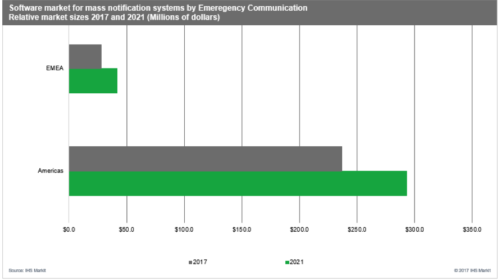I n the Americas, hurricanes, tornadoes and earthquakes are occurring more frequently, so unimpeded mass communication during these events is critical. MNS software is often employed so companies can communicate with their employees, federal agencies, university students and the general public. More channels of communication available in these types of events, means more people can reach safety faster and more lives can be saved.
In Western Europe, the second-largest market for MNS software, weather-related incidents occur less often, How Catastrophic Events are Changing Mass-Notification System Market By Robert Brooks – Analyst, Security and Building Technologies, IHS Markit cooperation with the INTERPOL National Central Bureau in Vienna and private sector partners NEC Corporation and Cyber Defense Institute. “NEC has contributed as a strategic partner to INTERPOL’s commitment to improve the cybersecurity skills of investigators throughout the world. For the third year, NEC is honored to have helped develop the Digital Security Challenge by providing our expertise at this cutting-edge event,” said Kozo Matsuo, Vice President of NEC Corporation’s Cyber Security Strategy Division. Training sessions to develop participants’ practical knowledge on IoT device analysis and the latest trends in malware-related crime were delivered by specialists from NEC Corporation, InfoSec, Meiya Pico, SECOM, Kaspersky Lab and Trendso the need for MNS software is lower than in the Americas. While individual countries might deal with specific weather threats – like blizzards and freezes in Sweden and flooding in the UK – in 2017 the United States alone experienced four major hurricanes.
Mass-notification system (MNS) software used in emergency communication, the primary segment used during a catastrophic event, is expected to grow in the  Americas at a compound annual growth rate (CAGR) of 6.8 percent from 2017 to 2021, reaching $293.1 million in 2021.
Americas at a compound annual growth rate (CAGR) of 6.8 percent from 2017 to 2021, reaching $293.1 million in 2021.
Due to heightened terrorist activity in Europe, and with US-based multinational companies moving to Western Europe, the MNS software emergency communication market in EMEA is expected to grow at a CAGR of 11.4 percent from 2017 to 2021, reaching $41.6 million in 2021.
Our Analysis
FedRAMP opens the door for cloud-based solutions
Federal Risk and Authorization Management Program (FedRAMP) is a US government program providing a new standardized approach to security assessment, authorization and continuous monitoring for cloud products and services. While this certification is not mandated by law, it will certainly affect how software-as-a-service (SaaS) and cloud vendors perform business with federal government agencies – increasing MNS software sales by the federal government, because nearly all vendors in this industry will switch to cloud-based solutions.
Once a company is certified by FedRAMP, additional measures to buy or maintain vendors’ solutions is required. This cost savings will appeal to many government agencies as they look at the total cost to own a system.
Western European governments will continue to use on-premises or hybrid solutions, because they are constrained by local laws and regulations surrounding the use of personal information and privacy. A majority of cloud-based MNS software market leaders are located in the US, which creates additional lag time for cloud systems to be purchased in European countries.
New MNS platforms can reduce human error
There is an obvious and growing need for more user-friendly system interfaces. For example, during a regulated standard test of Hawaii’s emergency missile warning system in January 2018, an employee selected the option to send out a full missiledefense alert, instead of choosing the test-cycle option. While this is a dramatic example of human error, there is a continuing need to improve the user interfaces of these systems to avoid unnecessary public panic in the future.
Privacy laws and regulations slow cloud-based MNS software adoption across Europe
I ncreasing acts of terrorism across Western Europe and North Africa over the past two years have forced central governments to investigate new and innovative ways to keep the general public safe. While most investment goes toward security cameras, access control, security doors and tough perimeter security, some governments will also choose to buy MNS software to facilitate communication between first responders and security teams.
Privacy issues need to be addressed on a country-by-country basis, including the location of servers hosting cloud-based platforms. In Germany for example, MNS software providers must comply with the ‘German work first’ rule. This rule was implemented by the German government, because it did not want any German citizen’s information to be contained outside the country. Each country in the European market has different rules about hosted systems, which adds another layer of complexity to selling cloud-based systems in Europe.
Security Technology
I HS Markit provides extensive coverage of security technology markets, encompassing access control and fire, cybersecurity, digital ID, critical communications and video surveillance.